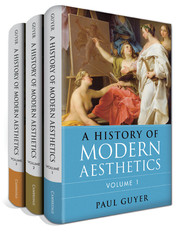Book contents
- Volume 1 The Eighteenth Century
- Volume 2 The Nineteenth Century
- Frontmatter
- Contents
- Acknowledgments
- Introduction
- Part One German Aesthetics in the First Half of the Nineteenth Century
- 1 Early Romanticism and Idealism
- 2 High Romanticism in the Shadow of Schelling
- 3 The High Tide of Idealism
- 4 In the Wake of Hegel
- Part Two (Mostly) British Aesthetics in the Second Half of the Nineteenth Century
- Part Three German Aesthetics in the Second Half of the Nineteenth Century
- Bibliography
- Index
- Volume 3 The Twentieth Century
- References
2 - High Romanticism in the Shadow of Schelling
from Part One - German Aesthetics in the First Half of the Nineteenth Century
Published online by Cambridge University Press: 05 June 2015
- Volume 1 The Eighteenth Century
- Volume 2 The Nineteenth Century
- Frontmatter
- Contents
- Acknowledgments
- Introduction
- Part One German Aesthetics in the First Half of the Nineteenth Century
- 1 Early Romanticism and Idealism
- 2 High Romanticism in the Shadow of Schelling
- 3 The High Tide of Idealism
- 4 In the Wake of Hegel
- Part Two (Mostly) British Aesthetics in the Second Half of the Nineteenth Century
- Part Three German Aesthetics in the Second Half of the Nineteenth Century
- Bibliography
- Index
- Volume 3 The Twentieth Century
- References
Summary
Schelling had an immediate and tremendous influence not only on fellow philosophers – as we shall soon see, both Schopenhauer and Hegel were deeply influenced by him, although in different ways – but also on more literary writers who indulged in theorizing in the first decades of the nineteenth century. Before we continue our survey of the major philosophical aestheticians of German idealism, a brief discussion of several of these writers who worked in the penumbra of Schelling in these decades is in order. We will consider first the German novelist “Jean Paul,” whose theoretical work appeared in the first decade of the century. Then we will turn to the English poet and journalist Samuel Taylor Coleridge, whose chief work in philosophy and aesthetics appeared in the second decade of the century, and also take a brief look at the aesthetic attitudes expressed by fellow British Romantics William Wordsworth and Percey Bysshe Shelley, as well as several early essays on the philosopher John Stuart Mill. Finally, we will turn to the American Ralph Waldo Emerson, whose relevant works appeared in the next generation. We will find that these representatives of later Romanticism, as opposed to the “early Romanticism” represented by Friedrich Schlegel, largely share the cognitivist approach to art, the conception of art as the “organon of philosophy” of Schelling, although in the writings of the poets Wordsworth and Shelley we also find expressions of the view that the point of their poetic art is not just to afford insight into the nature of human emotions but to stir them. Surprisingly, the most unequivocal assertion that the point of poetry, and by implication art in general, is to arouse deeply felt human emotions comes from the utilitarian philosopher Mill.
- Type
- Chapter
- Information
- A History of Modern Aesthetics , pp. 57 - 105Publisher: Cambridge University PressPrint publication year: 2014



